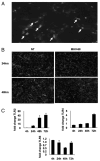Viral infection of the placenta leads to fetal inflammation and sensitization to bacterial products predisposing to preterm labor
- PMID: 20554966
- PMCID: PMC3041595
- DOI: 10.4049/jimmunol.1000289
Viral infection of the placenta leads to fetal inflammation and sensitization to bacterial products predisposing to preterm labor
Erratum in
- J Immunol. 2011 Sep 1;187(5):2835. Booth, Carmen [corrected to Booth, Carmen J]
Abstract
Pandemics pose a more significant threat to pregnant women than to the nonpregnant population and may have a detrimental effect on the well being of the fetus. We have developed an animal model to evaluate the consequences of a viral infection characterized by lack of fetal transmission. The experiments described in this work show that viral infection of the placenta can elicit a fetal inflammatory response that, in turn, can cause organ damage and potentially downstream developmental deficiencies. Furthermore, we demonstrate that viral infection of the placenta may sensitize the pregnant mother to bacterial products and promote preterm labor. It is critical to take into consideration the fact that during pregnancy it is not only the maternal immune system responding, but also the fetal/placental unit. Our results further support the immunological role of the placenta and the fetus affecting the global response of the mother to microbial infections. This is relevant for making decisions associated with treatment and prevention during pandemics.
Conflict of interest statement
Figures






References
-
- Nuzum JW, Pilot I, Stangl FH, Bonar BE. 1918 pandemic influenza and pneumonia in a large civil hospital. IMJ Ill Med J. 1976;150:612–616. - PubMed
-
- Romero R, Espinoza J, Chaiworapongsa T, Kalache K. Infection and prematurity and the role of preventive strategies. Semin Neonatol. 2002;7:259–274. - PubMed
-
- Jamieson DJ, Honein MA, Rasmussen SA, Williams JL, Swerdlow DL, Biggerstaff MS, Lindstrom S, Louie JK, Christ CM, Bohm SR, et al. Novel Influenza A (H1N1) Pregnancy Working Group H1N1 2009 influenza virus infection during pregnancy in the USA. Lancet. 2009;374:451–458. - PubMed
-
- Burguete T, Rabreau M, Fontanges-Darriet M, Roset E, Hager HD, Köppel A, Bischof P, Schlehofer JR. Evidence for infection of the human embryo with adeno-associated virus in pregnancy. Hum Reprod. 1999;14:2396–2401. - PubMed
-
- Basurko C, Carles G, Youssef M, Guindi WE. Maternal and fetal consequences of dengue fever during pregnancy. Eur J Obstet Gynecol Reprod Biol. 2009;147:29–32. - PubMed
Publication types
MeSH terms
Substances
Grants and funding
LinkOut - more resources
Full Text Sources
Other Literature Sources
Molecular Biology Databases

